CAA News Today
Top News in 2015 from the Art and Academic Worlds
posted by Christopher Howard — December 30, 2015
As 2015 comes to a close, CAA would like to wish a safe and happy holiday season to its members, subscribers, partners, and other visual-arts professionals. As we reflect on the past twelve months, we would like to offer CAA News readers a look at the most accessed articles from the past year.
I’m a Liberal Professor, and My Liberal Students Terrify Me
I’m a professor at a midsize state school. I have been teaching college classes for nine years now. I have won (minor) teaching awards, studied pedagogy extensively, and almost always score highly on my student evaluations. Yet things have changed since I started teaching. The vibe is different. I wish there were a less blunt way to put this, but my students sometimes scare me—particularly the liberal ones. (Read more from Vox.)
Why Absolutely Everyone Hates Renoir
When God-Hates-Renoir protesters recently rallied outside the Museum of Fine Arts in Boston, there was only one reason why anyone might have been surprised to see them there. The museum isn’t mounting a big Renoir show, or celebrating the artist in some other way. Any institution foolhardy enough to do so knows by now to expect some kind of pushback, because everyone hates Renoir, and everyone always has. (Read more from the Atlantic.)
Entire USC First-Year MFA Class Is Dropping Out
We are a group of seven artists who made the decision to attend USC Roski School of Art and Design’s MFA program based on the faculty, curriculum, program structure, and funding packages. We are a group of seven artists who have been forced by the school’s dismantling of each of these elements to dissolve our MFA candidacies. In short, due to the university’s unethical treatment of its students, we, the entire incoming class of 2014, are dropping out of school and dropping back into our expanded communities at large. (Read more from Art and Education.)
Speaking for the “Quitters” and “Failures”
In the eyes of many academics, as Leonard Cassuto recently pointed out, I am considered a failure because I did not earn a doctorate. Meanwhile, American universities are awarding more doctorates than ever. And yet I have something most of those newly minted PhDs will never have: a full-time, tenured teaching job. (Read more from the Chronicle of Higher Education.)
Why Is College So Expensive If Professors Are Paid So Little?
Twenty-five years ago, a student at a public college or nonresearch university campus would see twice as many faculty as administrators on average; now the ratio is roughly equal. Just 20 percent of the teaching workforce in 2013 were permanent or tenure track. About half worked part-time or as adjuncts, often stitching together temporary gigs at different institutions. (Read more from the Nation.)
Dealing with Inappropriate Emails from Students
About once a week I will open my inbox and be greeted by an email that will leave me at a loss for words. A few nights ago, for instance, one student emailed me at 10:30 PM on a Sunday requesting—”urgently”—a meeting at 7:30 the next morning. She wanted to discuss an assignment that was due the day after and couldn’t make it any other time during the day. I decided not to respond—at least not immediately. (Read more from GradHacker.)
Making the Most of the Syllabus
On the first day of class, after a brief introduction to the class topic and my related background, I pass out the syllabus in hard copy. We then read the document together out loud. I ask a student to read the first paragraph. Then the next student reads the next paragraph, and so on. In addition to ensuring that every student reads the entire syllabus, I help students get over possible anxieties about hearing themselves speak in front of their peers. (Read more from Inside Higher Ed.)
What Ever Happened to Google Books?
It was the most ambitious library project of our time—a plan to scan all of the world’s books and make them available to the public online. “We think that we can do it all inside of ten years,” Marissa Mayer, who was then a vice president at Google, said to the New Yorker in 2007, when Google Books was in its beta stage. “It’s mind-boggling to me, how close it is.” Today, the project sits in a kind of limbo. (Read more from the New Yorker.)
Great Colleges to Work for 2015
This special issue features results of the Chronicle’s eighth annual Great Colleges to Work For survey, based on responses from nearly 44,000 campus employees. The survey found that at colleges recognized for a strong workplace culture, employees were more likely to feel acknowledged, supported, well informed by their leaders, and engaged in a common mission. (Read more from the Chronicle of Higher Education.)
Dying of Exposure
At some point, two years ago, maybe, I stopped doing things for free: no free writing, no free talks, no free critiques with artists or art students, nothing. I didn’t make the decision out of avarice; I made it as a matter of survival. I used to accept all kinds of invitations to do such things, paid or not, when I was a tenured professor. But, of course, the privilege of not having to think about my intellectual labor in those terms was predicated on the very fact that I was being paid, by my university, if not by the publishers, colleges, students, or artists who hosted the events to which I was invited. (Read more from Art Practical.)
Thirty Art-Writing Clichés to Ditch in the New Year
It’s a new year, which is a fine excuse as any to ditch old bad habits. Here below, I have assembled a not-at-all exhaustive list of art-writing words that I could do without in 2015. I admit that I’ve been guilty myself of abusing some or all of them—but of course that’s what New Year’s resolutions are for. (Read more from Artnet News.)
Behind the Impasse That Led USC’s 2016 MFA Students to Withdraw in Protest
The graduate class of 2016 at USC’s Roski School of Art and Design has withdrawn in protest from the visual-arts program over administration and curriculum changes. The conflict stems from changes made to the program after students had already arrived on campus, as well as resignations by prominent faculty members. (Read more from the Los Angeles Times.)
Is Adjuncting the “Kiss of Death”?
Numerous commentators have observed that being an adjunct, as a recent essay put it, “actually seems to decrease your chances of securing a tenure-track position.” Some have even gone so far as to label adjuncting a career destroyer, the proverbial “kiss of death.” But is it really? (Read more from Vitae.)
The Hostile Renegotiation of the Professor-Student Relationship
There is a scourge on college campuses today, driving a wedge between students and faculty. Political correctness? Maybe that, too. But I’m referring instead to the newly triumphant caricature of today’s undergrad (and perhaps some grad students as well) as a hypersensitive, helicoptered student-customer who will file a Title IX complaint if the dining hall kale isn’t organic. Today’s undergrad is so entitled as to demand to be employable after graduation. (Read more from the New Republic.)
O Adjunct! My Adjunct!
I spent half of my undergraduate career figuring out what I didn’t want to do. I started off in the journalism program, switched to literature, was undecided for a few panicked, free-floating months, and studied photography for a time. But the spring of my sophomore year, I enrolled in a fiction-writing workshop with an instructor named Harvey Grossinger. What I didn’t know at the time—and what I wouldn’t figure out for the better part of the next decade—was that Harvey was an adjunct. He didn’t tell us, and I didn’t know to ask. As an undergraduate, I never heard the term. (Read more from the New Yorker.)
The Conference Manifesto
We are weary of academic conferences. We are humanists who recognize very little humanity in the conference format and content. We have sat patiently and politely through talks read line by line in a monotone voice by a speaker who doesn’t look up once, wondering why we couldn’t have read the paper ourselves in advance with a much greater level of absorption. (Read more from the New York Times.)
How Art Became Irrelevant
In terms of quantifiable data—prices spent on paintings and photographs and sculptures, visitors accommodated, funds raised, and square footage created at museums—the picture could hardly be rosier. Equally robust is the art market, to judge by a Christie’s auction on May 11 that set several records, including the highest price ever paid at auction for a work of art. But quantifiable data can only describe the fiscal health of the fine arts, not their cultural health. Here the picture is not so rosy. (Read more from Commentary.)
Dear Liberal Professor, Students Aren’t the Problem
In a recent Vox essay, a self-described “liberal professor,” writing under a pseudonym, explained how students had changed over his nine years in the college classroom. His liberal students now “terrify” him, he wrote, with their identity politics and imagined grievances. Here we go, I thought, another lament of the loss of white-male privilege, this time set at the university. What I quickly realized, however, was that the essay might be better characterized as a jeremiad, a cautionary tale that exaggerates current woes to elicit social change. (Read more from Vitae.)
The Benefits of No-Tech Note Taking
The moment of truth for me came in the spring 2013 semester. I looked out at my visual-communication class and saw a group of six students transfixed by the blue glow of a video on one of their computers, and decided I was done allowing laptops in my large lecture class. “Done” might be putting it mildly. Although I am an engaging lecturer, I could not compete with Facebook and YouTube, and I was tired of trying. The next semester I told students they would have to take notes on paper. Period. (Read more from the Chronicle of Higher Education.)
Historian Uses Lasers to Unlock Mysteries of Gothic Cathedrals
Thirteen million people visit the Notre Dame Cathedral in Paris every year, entering through massive wooden doors at the base of towers as solidly planted as mountains. They stand in front of walls filigreed with stained glass and gaze at a ceiling supported by delicate ribs of stone. If its beauty and magnificence is instantly apparent, so much about Notre Dame is not. To begin with, we don’t know who built this cathedral—or how. (Read more from National Geographic.)
I’m Paid Less Than My Colleagues. Help!
I’m in the biological sciences at an R1 school and am a relatively new full professor. Recently, I was shown the mean salary for all faculty at this rank within my department. To my surprise, my salary was about 20 percent less than this number. Meanwhile the mean salary for full professors in my department is approximately 6 percent lower than the average provided by the Chronicle’s latest salary report for my university. (Read more from Vitae.)
What’s the Point of a Professor?
In the coming weeks, two million Americans will earn a bachelor’s degree and either join the work force or head to graduate school. They will be joyous that day, and they will remember fondly the schools they attended. But as this unique chapter of life closes and they reflect on campus events, one primary part of higher education will fall low on the ladder of meaningful contacts: the professors. (Read more from the New York Times.)
Slow Teaching
At some point on the first day of classes I am going to ask my students to answer some questions anonymously. In all honesty, why did you enroll in this course? What final grade you would be happy with? What about this class are you most concerned or anxious about? Exploring students’ responses over the years has led me to identify two prevailing suspicions: that art-history courses are based on rote memorization of names and dates, and that class time will consist of a battery of artworks crammed into a swiftly delivered lecture. (Read more from Art History Teaching Resources.)
A Guide to Thesis Writing That Is a Guide to Life
How to Write a Thesis, by Umberto Eco, first appeared on Italian bookshelves in 1977. For Eco, the playful philosopher and novelist best known for his work on semiotics, there was a practical reason for writing it. Up until 1999, a thesis of original research was required of every student pursuing the Italian equivalent of a bachelor’s degree. Collecting his thoughts on the thesis process would save him the trouble of reciting the same advice to students each year. (Read more from the New Yorker.)
What Are Some Good Art Documentaries?
What are some worthwhile art documentaries? I am an art instructor and working on compiling a list of films for my students to watch in their spare time. Any suggestions? (Read more from Burnaway.)
Six Dos and Don’ts for Gallery Representation
The road to getting into a gallery can seem impossibly rocky with obstacles at every turn. How do you know if you’re choosing the right path and using the right approach? We chatted with a veteran gallery owner and turned to the experts for six important dos and don’ts to achieving gallery representation. (Read more from Artwork Archive.)
Thirteen Art-History Emojis We Desperately Wish Were Real
This one goes out to all the art-savvy texters of the world, looking to add some of history’s finest manifestations of creative expression to their OMGs and LOLs. It’s been over two years since the glory days of #emojiarthistory, when the art world banded together to adapt art classics into emojis using the options available. What if, instead of using two dancing ballerinas to signify a Diane Arbus photo, there existed a whole realm of ready-made art emojis based on the canon of art history? (Read more from the Huffington Post.)
The Art of Having Difficult Conversations
The ability to have difficult conversations is important for career success, productivity, and relationships in almost every field, and higher education is no exception. However, despite the need to have these conversations, the idea of addressing sensitive issues can be scary. This article provides strategies for having difficult conversations and gives example scripts. (Read more from Inside Higher Ed.)
Ten Tips for More Efficient and Effective Grading
Many instructors dread grading, not just because grading takes up a sizable amount of time and can prove itself a tedious task, but also because instructors struggle with grading effectively and efficiently. However, effective grading does not have to take inordinate amounts of time, nor does one need to sacrifice quality for speed. The following tips can help instructors grade more effectively while enhancing student learning. (Read more from Faculty Focus.)
A Win for Academic Freedom: Steven Salaita Awarded Back-to-Back Victories against University That Fired Him
The first part of June has awarded back-to-back victories to Steven Salaita, a professor who last year was dismissed from his post at the University of Illinois, Urbana-Champaign, for posting tweets considered by some to be beyond the pale of proper academic discourse. What makes this case especially interesting—and what the recent court decision and a critical vote by the largest confederation of US professors in the country shows—is the undue and improper interference of wealthy donors on the internal affairs of public educational institutions. (Read more from Salon.)
There Is No Excuse for How Universities Treat Adjuncts
Apart from feeling sorry for the underpaid faculty, why should we care that college professors have the same job conditions as day laborers, fast-food workers, cashiers, taxi drivers, or home-care aides? They did, after all, choose to pursue a career in higher ed. Administrators at these institutions of higher learning argue that they need to use adjuncts because it is the only way to keep tuition from rising even faster than it has. And isn’t access to education the higher good? (Read more from the Atlantic.)
Re: Your Recent Email to Your Professor
In the age of social media, many students approach emailing similar to texting and other forms of digital communication, where the crucial conventions are brevity and informality. But most college teachers consider emails closer to letters than to text messages. This style of writing calls for more formality, more thoroughness, and more faithful adherence to the conventions of Edited Standard Written English—that is, spelling, punctuation, capitalization, and syntax. (Read more from Inside Higher Ed.)
Using Smarthistory to Generate Good Conversations in the Art-History Survey
I had been aware of Smarthistory for years, occasionally assigning videos as supplemental readings and directing students to its content. But following their use of the Khan Academy platform in 2011, the site’s content expanded exponentially. Suddenly, there were enough videos on diverse topics that I could assign Smarthistory videos for every topic in my syllabus. (Read more from Smarthistory.)
Does Color Even Exist?
Color perception is an ancient and active philosophical problem. It’s an instance of the wider category of sensory perception, but since the color spectrum fits on a single line, it has always been of particular interest. In her new book Outside Color, M. Chirimuuta gives a serendipitously timed history of the puzzle of color in philosophy. To read Outside Color as a layman feels like being let in on a shocking secret: neither scientists nor philosophers know for sure what color is. (Read more from the New Republic.)
That “Useless” Liberal-Arts Degree Has Become Tech’s Hottest Ticket
Stewart Butterfield, Slack Technologies’ cofounder and CEO, proudly holds an undergraduate degree in philosophy from Canada’s University of Victoria and a master’s degree from Cambridge in philosophy and the history of science. “Studying philosophy taught me two things,” says Butterfield. “I learned how to write really clearly. I learned how to follow an argument all the way down, which is invaluable in running meetings.” (Read more from Forbes.)
There’s a Game for That: Teaching Art History with “Reacting to the Past”
When faculty facilitate involvement in activities such as simulations and games, and when students work collaboratively through role play and debate, deeper learning and transfer occurs. As part of my efforts to include more active and student-centered learning opportunities into my courses and to encourage knowledge, skills, and attitudes that support higher-order thinking tasks such as analysis, synthesis, and evaluation, I added a “Reacting to the Past” role-playing game to my introductory-level art-history course. (Read more from Art History Teaching Resources.)
Two Bronzes Attributed Convincingly to Michelangelo
A team of art historians, scientists, and anatomical experts has announced that a pair of bronze statues—meter-high, idealized, muscular nude male followers of the god Bacchus riding panthers—are by Michelangelo and date from around 1508–10. The pair, which is in a private collection, will go on display on February 3 at the Fitzwilliam Museum in Cambridge. (Read more from the Art Newspaper.)
An Illustrated Guide to Arthur Danto’s “The End of Art”
In an obituary for the New York Times, Ken Johnson described Arthur Danto as “one of the most widely read art critics of the Postmodern era.” Danto, both a critic and a professor of philosophy, is celebrated for his accessible and affable prose. Despite this, his best-known essay, “The End of Art,” continues to be cited more than it is understood. What was Danto’s argument? Is art really over? And if so, what are the implications for art history and art making? (Read more from Hyperallergic.)
News from the Art and Academic Worlds
posted by Christopher Howard — December 23, 2015
Each week CAA News publishes summaries of eight articles, published around the web, that CAA members may find interesting and useful in their professional and creative lives.
Academics: Forget about Public Engagement, Stay in Your Ivory Towers
Academics are constantly encouraged to engage with the public more often, but this advice ignores the way that specialized knowledge already affects civic life. Specialization has social importance—but often only after decades of work. It is time for us to reassess what we mean by public scholarship. We must recognize the value of the esoteric knowledge, technical vocabulary, and expert histories that academics produce. (Read more from the Guardian.)
Give Your Syllabus an Extreme Redesign for the New Year
Do you ever feel like you want to get more out of your syllabus? Sure, it plays center stage during the first day of class, but does it really have to end there? Perhaps it’s a matter of presentation. (Read more from GradHacker.)
Built-In Self-Assessment: A Case for Annotation
If we want students to be critical thinkers, we must routinely and explicitly give them structured practice opportunities to critically examine their own thinking. Squeezing two or three metacognitive activities into a hectic semester teaches students that such reflection is only for special occasions. Rather, student self-evaluation should be a daily course routine. (Read more from Faculty Focus.)
Virtual-Reality Lab Explores New Kinds of Immersive Learning
For students attending class via webcam or video lecture, the video is two dimensional, and the audio doesn’t sound as it would if they were in a real classroom. Ramani Duraiswami, a computer-science professor and cofounder of the start-up company VisiSonics, thinks virtual-reality technology could help the experience feel more immersive. (Read more from the Chronicle of Higher Education.)
Dual Careers, One Academic
I’ve seen a lot written and discussed about the so-called two-body problem, as universities take on the challenge of dual-career couples coming into a new position. It’s a particularly important issue in my field, as the majority of married women in it are married to men in the field. The problem is that I’m not one of them, as I married someone whose career is outside academia. (Read more from Tenure, She Wrote.)
Swiss Artists Program Laptop to Make Random Purchases from the Dark Web
It’s unlikely that police will swoop down on a south London art gallery and apprehend a laptop that is busy making random purchases from a secretive part of the web known as the dark net. Then again, it depends what the automated shopping bot known as Random Darknet Shopper chooses to buy online and have delivered to the gallery. (Read more from the Independent.)
New Site Lets You Report Facebook and Other Networks When They Censor Art
Nudity in art has been around for thousands of years, but Facebook still can’t take it. The social-media site has blocked users like Frédéric Durand-Baïssas for sharing paintings, including Gustave Courbet’s L’Origine du Monde. Though some people have protested by creating Facebook groups like Artists Against Art Censorship, recording every instance of censorship—let alone fighting back—is next to impossible. (Read more from Hyperallergic.)
Art History, Feminism, and Wikipedia
What might the internet’s most popular general reference and free-access encyclopedia (not to mention the fifth-largest website in the world) offer a centuries-old academic discipline? How might its participatory model—the fact that anyone can access and edit most of its articles—generate new stakeholders in and audiences for our field? (Read more from Art History Teaching Resources.)
Solo Exhibitions by Artist Members
posted by CAA — December 22, 2015
Solo Exhibitions by Artist Members
See when and where CAA members are exhibiting their art, and view images of their work.
Solo Exhibitions by Artist Members is published every two months: in February, April, June, August, October, and December. To learn more about submitting a listing, please follow the instructions on the main Member News page.
December 2015
Abroad
Patricia Cronin. Chiesa di San Gallo, 56th Venice Biennale Collateral Event, Venice, Italy, May 6–November 22, 2015. Shrine for Girls, Venice.
Lindsey Landfried. Kwadrat Gallerie, Berlin, Germany, October 17–November 14, 2015. Scripture. Drawing installation.
Mid-Atlantic
H. K. Anne. George Washington University, Virginia Science and Technology Campus, Enterprise Hall, Ashburn, Virginia, September 16–December 31, 2015. Goose Creek, the Four Seasons. Oil painting.
Midwest
Sharon Louden. Tweed Museum of Art, University of Minnesota, Duluth, Minnesota, October 22, 2015–May 29, 2016. Windows. Site-specific multimedia installation.
Northeast
Craig Drennen. Temporary Storage Gallery, Gallery 104, Brooklyn, New York, September 8–October 9, 2015. New Mistress vs. Old Athenians. Painting and mixed media.
Michael Rich. Candita Clayton Gallery, Pawtucket, Rhode Island, September 24–October 15, 2015. Large Scale! New and Recent (Big) Paintings. Painting.
South
Michael Aurbach. Vanderbilt University Fine Arts Gallery, Nashville, Tennessee, January 14–March 3, 2016. The Last Laugh: Selections from Michael Aurbach’s Secrecy Series. Sculpture.
West
Ellen Carey. M+B, Los Angeles, California, November 6, 2015–January 16, 2016. Ellen Carey: Polaroid 20 x 24 Self-Portraits. Photography.
Julie Green. Upfor, Portland, Oregon, November 5–December 19, 2015. My New Blue Friends. Painting.
Steven Labadessa. COS Art Gallery, College of the Sequoias, Visalia, California, October 6–30, 2015. Steven Labadessa: Hallucinatory Realism. Painting, drawing, and mixed media.
Conference Registration Extended to January 6, 2016!
posted by Nia Page — December 18, 2015
UPDATE: CONFERENCE REGISTRATION HAS BEEN EXTENDED TO WEDNESDAY, JANUARY 6, 2016.
The clock is ticking! Early Conference Registration Rates end December 21, 2015! Submit your Individual Registration Information to attend the largest gathering of visual arts professionals! This year, don’t miss Tania Bruguera, the chairs of the NEA and NEH, MacArthur Fellows LaToya Ruby Frazier and Rick Lowe, and much more!
 We are very pleased to invite you to join us for the College Art Association’s Annual Conference. The 104th Annual Conference will be held in Washington, DC at the Washington Marriott Wardman Park Hotel from Wednesday, February 3 to Saturday, February 6, 2016. As the world’s largest international forum for professionals in the visual arts, the conference offers more than 200 sessions, panel discussions, roundtables, and meetings on topics in current art scholarship and practice. Join more than 4,000 artists, art historians, designers, museum directors and curators, arts administrators, and educators in networking opportunities and the exchange of ideas and information between colleagues from across the globe. We invite you to join us.
We are very pleased to invite you to join us for the College Art Association’s Annual Conference. The 104th Annual Conference will be held in Washington, DC at the Washington Marriott Wardman Park Hotel from Wednesday, February 3 to Saturday, February 6, 2016. As the world’s largest international forum for professionals in the visual arts, the conference offers more than 200 sessions, panel discussions, roundtables, and meetings on topics in current art scholarship and practice. Join more than 4,000 artists, art historians, designers, museum directors and curators, arts administrators, and educators in networking opportunities and the exchange of ideas and information between colleagues from across the globe. We invite you to join us.
This year’s highlights include Convocation Keynote address by Cuban installation and performance artist, Tania Bruguera; Opening Night Reception at the Katzen Center at American University; and the Fourteenth Annual Distinguished Scholar session honoring Richard J. Powell, John Spencer Bassett Professor of Art and Art History and Dean of Humanities at Duke University.
Additional highlights include the NEA and NEH 50th Anniversary Presentation Lecture with Jane Chu, Chair of the NEA, in conversation with William “Bro” Adams, Chairman of the NEH; the Annual Distinguished Artists’ Interviews with Joyce Scott, artist of social commentary on racism, sexism and violence, in conversation with George Ciscle, Curator-in-Residence of MICA; and conversation between two MacArthur “genius” fellowship recipients, Rick Lowe (2014) and LaToya Ruby Frazier (2015); Jarl Mohn; National Public Radio CEO and President, will speak on the visual arts and the public; a special tribute to Linda Nochlin, Lila Acheson Wallace Professor of Modern Art at New York University; and the Book and Trade Fair with over 120 publishers, art materials manufacturers, and services in the arts, and much more.
 The 2016 CAA conference will also host ARTspace, a conference within the conference. ARTspace is programmed by artists, and tailored to the interests and needs of artists. It is open to all attendees and includes the Annual Artists’ Interviews mentioned above, Media Lounge, and ARTexchange.
The 2016 CAA conference will also host ARTspace, a conference within the conference. ARTspace is programmed by artists, and tailored to the interests and needs of artists. It is open to all attendees and includes the Annual Artists’ Interviews mentioned above, Media Lounge, and ARTexchange.
CAA has arranged for a curator-led tour of “Marvelous Objects: Surrealist Sculpture From Paris to New York” at the Hirshhorn Museum and Sculpture Garden; a US Capitol Building Tour; a tour of the Kogod House and Art Collection (Donor Circle and Life Members only); a tour of the Glenstone Museum, a Charles Gwathmey-designed private museum housing prime examples of Post-WWII works; and tours of DC-based artist studios and galleries.
 CAA members receive substantial discounts on conference registration. For those members who are not eligible for CAA’s discounted memberships, the best overall value on combined membership and conference registration is with the Premium or Donor Circle level membership. CAA members at the Basic level planning to attend the Annual Conference are encouraged to upgrade to the Premium level, which when combined with the discounted conference registration will provide the greatest value. To upgrade your membership please email us or call 212.691.1051, ext. 1 with any feedback or questions.
CAA members receive substantial discounts on conference registration. For those members who are not eligible for CAA’s discounted memberships, the best overall value on combined membership and conference registration is with the Premium or Donor Circle level membership. CAA members at the Basic level planning to attend the Annual Conference are encouraged to upgrade to the Premium level, which when combined with the discounted conference registration will provide the greatest value. To upgrade your membership please email us or call 212.691.1051, ext. 1 with any feedback or questions.
CAA’s partners are offering exclusive discounts on airfare, car rentals, train travel, and hotel rooms to all conference attendees. Book now and save even more. It is strongly encouraged that you reserve your accommodations at one of the official Conference Hotels. Please note that CAA commits to a block of rooms at these hotels on behalf of its members and has a financial obligation to fill those blocks. Please help us avoid potential penalties and control costs for future events by staying at one of the official hotels.
We look forward to seeing you in DC!
People in the News
posted by CAA — December 17, 2015
People in the News lists new hires, positions, and promotions in three sections: Academe, Museums and Galleries, and Organizations and Publications.
The section is published every two months: in February, April, June, August, October, and December. To learn more about submitting a listing, please follow the instructions on the main Member News page.
December 2015
Academe
Adair Rounthwaite has been appointed assistant professor of art history in the School of Art, Art History, and Design at the University of Washington in Seattle. The position is tenure track.
Michael Schreffler, formerly a faculty member in the Department of Art History at Virginia Commonwealth University in Richmond, has joined the Department of Art, Art History, and Design at the University of Notre Dame in Indiana as associate professor of the art and architecture of Spain and Latin America in the sixteenth and seventeenth centuries.
Museums and Galleries
Cassandra Albinson has been appointed the new Margaret S. Winthrop Curator of European Art at the Harvard Art Museums in Cambridge, Massachusetts.
Christopher Atkins, coordinator of the Minnesota Artists Exhibition Program at the Minneapolis Institute of Art since 2009, has joined the Minnesota Museum of American Art in Saint Paul as curator of exhibitions and public programs.
Ethan Lasser has been named head of the Division of European and American Art at the Harvard Art Museums in Cambridge, Massachusetts. He was also promoted to Theodore E. Stebbins Jr. Curator of American Art—the first person to hold this endowed position.
Anne Manning, formerly deputy director for education and interpretation at the Baltimore Museum of Art in Maryland, has been appointed director of education and interpretive programs at the Nelson-Atkins Museum of Art in Kansas City, Missouri.
James Meyer, associate curator for the National Gallery of Art in Washington, DC, has been hired to serve as deputy director and chief curator of the Dia Art Foundation in New York.
Leslee Katrina Michelsen has left her position as head of curatorial research for the Museum of Islamic Art in Doha, Qatar. She is now a curatorial consultant for UNESCO Afghanistan.
Peter Nesbett, formerly associate director for programs at the Pew Center for Arts and Heritage in Philadelphia, Pennsylvania, has been appointed executive director of the Washington Project for the Arts in Washington, DC.
Stephen Pinson, formerly Robert B. Menschel Curator of Photography for the New York Public Library, has joined the Metropolitan Museum of Art in New York as curator of photography.
Elizabeth M. Rudy, who has been with the Harvard Art Museums in Cambridge, Massachusetts, since 2011, has been named the new Carl A. Weyerhaeuser Associate Curator of Prints.
Rachel Saunders has been named Abby Aldrich Rockefeller Associate Curator of Asian Art in the Division of Asian and Mediterranean Art at the Harvard Art Museums in Cambridge, Massachusetts. She is the first to hold this endowed position.
Emily Stamey, previously curator of contemporary art at the Scottsdale Museum of Contemporary Art in Arizona, has become curator of exhibitions at the University of North Carolina’s Weatherspoon Art Museum in Greensboro.
Elizabeth Varner has left her position as executive director of the National Art Museum of Sport in Indianapolis, Indiana. She is now staff curator at US Department of the Interior in Washington, DC.
Aileen June Wang has joined the Marianna Kistler Beach Museum of Art, part of Kansas State University in Manhattan, as associate curator. Prior to the appointment she was assistant professor of art history at Long Island University Post in Brookville, New York.
Gregory Wittkopp, director of the Cranbrook Art Museum and the Cranbrook Center for Collections and Research, both in Bloomfield Hills, Michigan, since 2011, has stepped down from the museum position. He will continue to lead the center.
Organizations and Publications
Tanya Sheehan, associate professor of art and chair of the Art Department at Colby College in Waterville, Maine, has been appointed guest editor of the Smithsonian Institution’s Archives of American Art Journal.
Institutional News
posted by CAA — December 17, 2015
Institutional News
Read about the latest news from institutional members.
Institutional News is published every two months: in February, April, June, August, October, and December. To learn more about submitting a listing, please follow the instructions on the main Member News page.
December 2015
The University of Virginia in Charlottesville has received a $30,000 grant from the National Endowment for the Arts for the testing and implementation of a prototype for digitizing artist’s books by a group of curators, artists, critics, and scholars.
CAA 2016 Board of Directors Election
posted by Vanessa Jalet — December 17, 2015
READ ABOUT CANDIDATES RUNNING FOR CAA’S BOARD OF DIRECTORS — VOTING BEGINS IN JANUARY 2016
The 2015 Nominating Committee has selected the following slate of six candidates for election to the CAA Board of Directors for the 2016-2020 term. Voting begins in early January 2016. Please go to CAA’s website to read each candidate’s statement, biography, and endorsement – and watch their video comments – before casting your vote. The candidates are:
- Dina Bangdel Associate Professor & Director, Art History Program, Virginia Commonwealth University in Qatar
- Carma Gorman Associate Professor & Assistant Chair, Department of Art and Art History, University of Texas at Austin
- N. Elizabeth Schlatter Deputy Director and Curator of Exhibitions, University of Richmond Museums, Richmond
- Andrew Schulz Associate Dean for Research & Associate Professor, College of Arts and Architecture, Pennsylvania State University
- Roberto Tejada Cullen Distinguished Professor, Departments of English and Art History, University of Houston
- Anuradha Vikram Lecturer, Graduate Public Practice, Otis College of Art and Design, Los Angeles
About the Board
The Board of Directors is charged with CAA’s long-term financial stability and strategic direction; it is also the Association’s governing body. The Board sets policy regarding all aspects of CAA’s activities, including publishing, the Annual Conference, awards and fellowships, advocacy, and committee procedures.
About the Election
CAA members may vote for no more than four (4) candidates (which may include one write-in candidate who must be a CAA member). The four candidates receiving the most votes will be elected to the Board. CAA members may cast their votes and submit their proxies online only. CAA holds the Board election on its own website. To vote, members will need only to log into their CAA member account.
All voting must take place prior to 5:00 p.m. EST on Wednesday, February 3, 2016. The results of the Board election will be announced at CAA’s Annual Business Meeting which is to be held at 5:30 p.m. EST at the start of Convocation at the Annual Conference in Washington on Wednesday, February 3, 2016 in the Marriott Ballroom, Salon 2, Lobby Level at the Washington Marriott Wardman Park Hotel, 2660 Woodley Road, NW., Washington, D. C. 20008. CAA’s President, DeWitt Godfrey, will preside.
Questions? Contact Vanessa Jalet, executive liaison, at (212) 392-4434 or vjalet@collegeart.org
News from the Art and Academic Worlds
posted by Christopher Howard — December 16, 2015
Each week CAA News publishes summaries of eight articles, published around the web, that CAA members may find interesting and useful in their professional and creative lives.
Confronting America’s Shameful Mass Incarceration with Art
Yoko Ono and Chris Burden are known for challenging the relationship between the art and the audience. The thirty-three-year-old performance artist Lech Szporer does this, too. But, unlike the hard-to-define nature of his antecedents, Szporer’s The Cage Project and its kin clearly express their purpose, and the performances are accompanied by actions that the larger public can more easily recognize as real. (Read more from the New Yorker.)
Help Desk: Culture and Compensation
The problem: sincere offers, from sweet, well-intended people, to show my work without compensation. The result: my polite refusal is taken as a slight, and I’m thought of as ungrateful. These people think they are doing me a favor and are confused when their request is turned down. What I’d like to have access to: an article written for the layperson that elucidates the situation. (Read more from Daily Serving.)
For Art to Flourish and Leave Its Trace
Art museums pledge to collect, display, study, interpret, and conserve works of art because those objects provide rich and soulful echoes of who we are. How will art made using interactive, decidedly variable, hastily obsolescent high-tech media fare? Digital and computer-based artworks are an active force behind retooling the museum and expanding methods of stewardship. (Read more from the Voices of Contemporary Art Journal.)
Researchers Observe Effects of Art on the Brain
When it comes to art, beauty may be in the eye of the beholder, but some scientists now are looking for it in bursts of brain waves. Seeking a biological basis for our response to art, researchers from the University of Houston recorded the electrical brain activity from 431 gallery visitors last year as they explored an exhibit of works by the conceptual artist Dario Robleto at the Menil Collection. (Read more from the Wall Street Journal.)
Influencing How Students Discuss Content
When students are talking with each other about content, many of us worry. We’ve all heard less-than-impressive exchanges. For example, four students are in a group discussing three open-ended questions about two challenging readings. In less than five minutes, they’re already on question three. Or, they’re working with clickers, supposedly exchanging ideas about a problem, but the group has already decided on one member’s solution. (Read more from Faculty Focus.)
Thoughts about Ashgate and Libraries
By now you are probably aware of the ongoing discussion about the fate of Ashgate Publishing, which was acquired by Informa last summer. Over the years Ashgate has increasingly become a respected venue for art historians, especially younger scholars publishing their early books on diverse and often groundbreaking topics that were organized—as the press matured—into a variety of interesting series. (Read more from the ARLIS/NA Collection Development SIG Blog.)
Breaking It to Your Family
We often discuss the effects of the tenure track on faculty lives. Much like the military, family members are also “drafted” into the academic lifestyle. Last month, we discussed how to break it to yourself that tenure does not mean less work. Here, we address this hard fact as it relates to families. The reality is that, even after gaining tenure, you may well face a relentless and often invisible set of career demands that can confuse and frustrate family members. (Read more from Inside Higher Education.)
Academic Job Hunts from Hell: Inappropriate, Hostile, and Awkward Moments
A doctoral student on the job market described a truly uncomfortable moment during a campus visit. An assistant professor giving her a campus tour stopped in front of an office filled with packing boxes and gestured inside, stating with a wistful air, “This is mine, or rather was. They are firing me; hence the opening.” Then he stood there, waiting for her reaction. My informant was so shocked that she responded, “That’s nice….” (Read more from the Chronicle of Higher Education.)
ARIAH’s East Asia Fellowship Program
posted by Christopher Howard — December 15, 2015
The Association of Research Institutes in Art History (ARIAH), a consortium of museums and research centers based in North America or affiliated with North American institutions, has established a new program that will strengthen intellectual connections among art-history disciplines in different regions of the world. With generous support from the Andrew W. Mellon Foundation, the Getty Foundation, and the Terra Foundation for American Art, ARIAH’s East Asia Fellowship Program will enable twelve scholars from countries in East Asia to conduct research at ARIAH member institutes on any topic in the visual arts. The project is funded for a three-year period, beginning in 2016, with four fellowships offered each year.
The East Asia Fellowship Program is open to scholars of art history from Japan, Mongolia, the People’s Republic of China (including Hong Kong and Macau), Taiwan, and South Korea. Each fellow will be hosted by an ARIAH member institute and have the opportunity to travel to other research centers during the three- to four-month fellowship period. Fellowships will be awarded through an open, competitive application process. One fellowship per year, supported specifically by the Terra Foundation, will focus on research topics related to the art of the United States before 1980. Topics for all other fellowships will be open, as long as they can be supported by research on the collections of the host institute. The deadline for the first of three rounds of fellowships is December 31, 2015.
“It’s impossible to overstate how important material support, not to mention encouragement, from the Mellon, Getty, and Terra foundations has been for launching this program,” said Jon Mogul, chair of ARIAH and assistant director for research and academic initiatives at the Wolfsonian–Florida International University in Miami Beach, Florida. “Art history and visual studies, like other academic fields, thrive when scholars who come from different traditions and view their subject through different lenses have the chance to learn from one another. The birth of this program really underscores just how essential these three foundations are to sustaining an ecosystem in which such intellectual interchange among art historians from different regions of the world can happen more and more routinely.”
The East Asia Fellowship Program grew out of a successful project that ARIAH designed in the late 1990s which brought art historians from Mexico, Central and South America, and the Caribbean to ARIAH member institutes. The Latin American program was part of larger process that yielded longer-term results and fostered increased collaboration and intellectual exchange among academic disciplines in Latin American countries.
ARIAH conceived of and developed the new program to encourage a similar intellectual, cross-cultural exchange between scholars and to establish lasting professional connections. The fellows will work side by side with curators, librarians, and fellows from other areas of research. Among the twenty-seven member organizations of ARIAH are the Metropolitan Museum of Art and the Getty Research Institute. The largest concentration of members can be found in the Smithsonian museums in the Washington, DC, area.
Peter Lukehart, associate dean of the Center for Advanced Study in the Visual Arts at the National Gallery of Art in Washington, DC, said that East Asia is “a geographic region from which, historically, there have been fewer applications” to the programs of ARIAH’s member institutes. “Consequently, the rich resources of these institutes are not known or available to scholars who might otherwise benefit from them. ARIAH hopes that encounters between scholars and administrators at ARIAH institutes will lead to future collaboration and interchange between fellows and their hosts. “Given the increasingly global nature of the discipline of art history,” Lukehart said, “these goals seem especially urgent.”
Grants, Awards, and Honors
posted by CAA — December 15, 2015
CAA recognizes its members for their professional achievements, be it a grant, fellowship, residency, book prize, honorary degree, or related award.
Grants, Awards, and Honors is published every two months: in February, April, June, August, October, and December. To learn more about submitting a listing, please follow the instructions on the main Member News page.
December 2015
Carol Becker, dean of faculty for Columbia University’s School of the Arts in New York, has received the Dayawait Modi Award for Art, Culture, and Education, given by Arts for India.
Henry Colburn, who recently completed a doctorate in the Interdepartmental PhD Program in Classical Art and Archaeology at the University of Michigan in Ann Arbor, has been awarded the ProQuest Distinguished Dissertation Award from the university’s Rackham Graduate School for the superior quality of his 2014 dissertation, “The Archaeology of Achaemenid Rule in Egypt.”
Craig Drennen, assistant professor of painting and drawing at Georgia State University in Atlanta, has accepted a fall 2015/winter 2016 residency at the MacDowell Colony in Peterborough, New Hampshire.
Barbara Foster, an artist based in Oakland, California, has received a spring 2016 residency at Playa in Summer Lake, Oregon.
Greg Hull, professor of sculpture in the Herron School of Art and Design at Indiana University–Purdue University Indianapolis, has been awarded a Transformational Impact Fellowship from the Arts Council of Indianapolis.
Larry A. Silver, James and Nan Wagner Farquhar Professor of History of Art at the University of Pennsylvania in Philadelphia, has been named a Phi Beta Kappa Visiting Scholar for the 2015–16 academic year.
Noah Simblist has won a 2015 Exhibition Grant from Artis for an exhibition, False Flags, he is organizing for Pelican Bomb in New Orleans, Louisiana, to take place in March 2016.





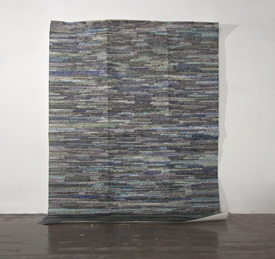 Lindsey Landfried, Recursive, 2015, acrylic on folded paper, 70 x 96 in. (artwork © Lindsey Landfried)
Lindsey Landfried, Recursive, 2015, acrylic on folded paper, 70 x 96 in. (artwork © Lindsey Landfried)
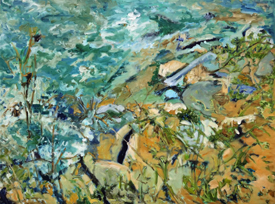 H. K. Anne, Rainy Spring, 2014, Leesburg, VA, 2015, oil on canvas, 45 x 58 in. (artwork © H. K. Anne; photograph by Suzanne K. Serway)
H. K. Anne, Rainy Spring, 2014, Leesburg, VA, 2015, oil on canvas, 45 x 58 in. (artwork © H. K. Anne; photograph by Suzanne K. Serway)
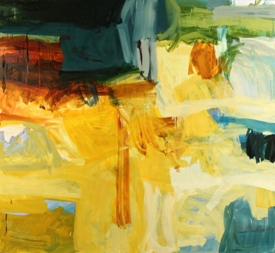 Michael Rich, The Desert Places, 2014, oil and wax on canvas. 64 x 70 in. (artwork © Michael Rich)
Michael Rich, The Desert Places, 2014, oil and wax on canvas. 64 x 70 in. (artwork © Michael Rich)
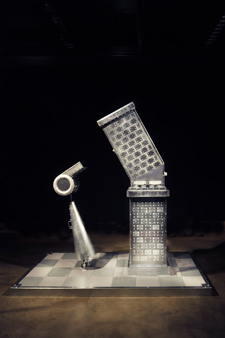 Michael Aurbach, Cassandra, 2016, mixed media, 96 x 96 x 48 in. (artwork © Michael Aurbach)
Michael Aurbach, Cassandra, 2016, mixed media, 96 x 96 x 48 in. (artwork © Michael Aurbach)
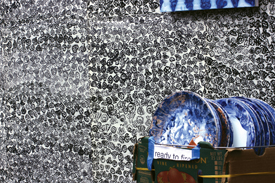 Julie Green, studio view of Wallpaper, Embarrassment of Dishes, and My New Blue Friends, 2015, sumi ink on mulberry paper, kiln-fired porcelain, and egg tempera airbrushed on panel, dimensions variable (artwork © Julie Green)
Julie Green, studio view of Wallpaper, Embarrassment of Dishes, and My New Blue Friends, 2015, sumi ink on mulberry paper, kiln-fired porcelain, and egg tempera airbrushed on panel, dimensions variable (artwork © Julie Green)
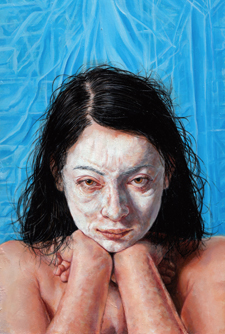 Steven Labadessa, hijikata 1, 2015, oil on copper, 12 x 7¾ in. (artwork © Steven Labadessa)
Steven Labadessa, hijikata 1, 2015, oil on copper, 12 x 7¾ in. (artwork © Steven Labadessa)
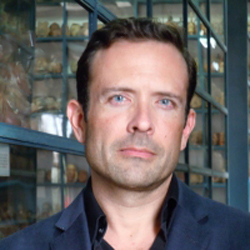 Michael Schreffler
Michael Schreffler
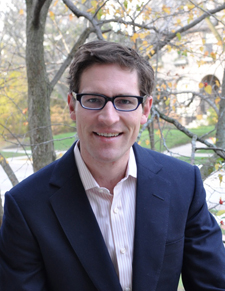 Ethan Lasser
Ethan Lasser
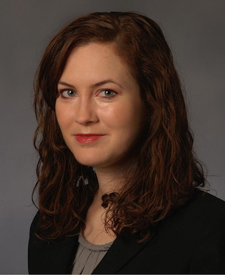 Elizabeth Varner
Elizabeth Varner
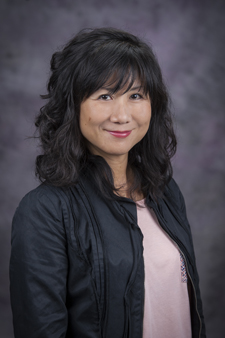 Aileen June Wang
Aileen June Wang
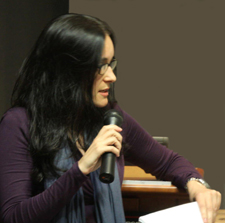 Tanya Sheehan
Tanya Sheehan
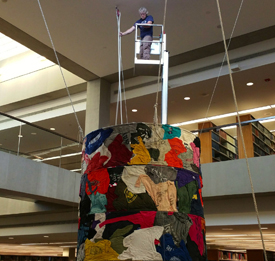 Greg Hull at work during an IUPUI student art installation
Greg Hull at work during an IUPUI student art installation
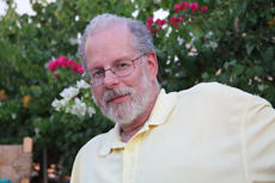 Larry A. Silver
Larry A. Silver